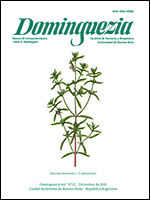Preliminary evaluation of the phytochemistry, antibacterial activity and toxicity in vitro of Lantana camara L. (Verbenaceae)
Keywords:
antimicrobial activity, genotoxicity, Lantana camara, phytochemical screening, acute toxicityAbstract
Lantana camara Linn. (Verbenaceae) is native to tropical and subtropical America and naturalized as an invasive species in other areas of America, Asia, Australia, Africa, Caribbean and Pacific Islands, and New Zealand. In Argentina, it is found in at least 11 provinces and is used as a digestive, carminative, febrifuge, diuretic, analgesic, antitussive, and in baths against rheumatism. In Argentina and some neighboring countries, toxicity to cattle is reported. The aims of this work are to report the secondary metabolites found in the phytochemical screening, the toxicity (acute in vitro and genotoxicity) and antimicrobial activity of the ethanolic extract of leaves of this plant. Secondary metabolites were examined by colorimetric reactions, thin-layer chromatography, paper chromatography, and spectrophotometry. The content of total phenols and total flavonoids was determined by colorimetric (with the Folin-Ciocalteu reagent) and complexation (with aluminum chloride) methods, respectively. Besides, acute in vitro toxicity (Artemia salina test), genotoxicity (Ames test), and antimicrobial activity were analyzed. The results revealed the presence of flavonoids, polyphenols, polysaccharides, proteins, tannins, triterpenes/steroids, and saponosides. The content of total phenols was 3.04 ± 6.10-2 mg EAG/ml extract and that of flavonoids 0.82 ± 4.10-2 mg EQ/ml extract. The mean lethal concentration higher than 1000 µg/ml extract and the mutagenic index lower than 2, would allow us to infer that this extract would be practically non-toxic. The activity against Gram-positive bacteria, mainly of the Staphylococcus genus, would be promising (MIC = 125-500 µg/ml). The results of the work contribute to broadening the scientific knowledge of the specie in our country, requiring more complex studies to enhance its chemical characterization.



